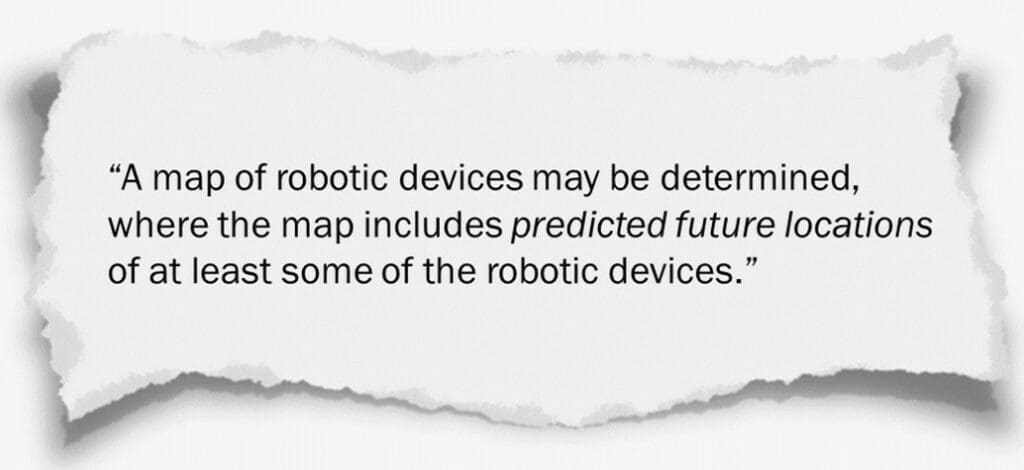 I spent some time yesterday looking through warehouse automation patents. I was curious about the methods and details of these systems that had been patented. If you have attended trade shows or viewed videos online of various mobile robots and other warehouse automation, it is likely that you have seen similarities in products of various suppliers. Sometimes the similarities are striking and make one wonder if there is potential patent infringement. But patent law and strategy are extremely complex, and I am certainly not able to distinguish infringement from competitive similarity. After all, filing a patent allows an assignee to place a stake in the ground, while also serving as a communications mechanism to the masses. As such, the filings can be very formal and drawn out, but also very informative. I searched the database and came across filings with familiar assignee (owners) names – some of the most prominent warehouse automation providers. But then I came across a filing assigned to company unfamiliar to me, X Development LLC. I looked it up and X Development LLC was formerly known as Google X.
I spent some time yesterday looking through warehouse automation patents. I was curious about the methods and details of these systems that had been patented. If you have attended trade shows or viewed videos online of various mobile robots and other warehouse automation, it is likely that you have seen similarities in products of various suppliers. Sometimes the similarities are striking and make one wonder if there is potential patent infringement. But patent law and strategy are extremely complex, and I am certainly not able to distinguish infringement from competitive similarity. After all, filing a patent allows an assignee to place a stake in the ground, while also serving as a communications mechanism to the masses. As such, the filings can be very formal and drawn out, but also very informative. I searched the database and came across filings with familiar assignee (owners) names – some of the most prominent warehouse automation providers. But then I came across a filing assigned to company unfamiliar to me, X Development LLC. I looked it up and X Development LLC was formerly known as Google X.
Google’s Dynamic Warehouse Mapping
The patent, dated May 21, 2019, is titled “Dynamically Maintaining a Map of a Fleet of Robotic Devices in an Environment to Facilitate Robotics Action.” I find the following line from the abstract to capture the essence of the novelty within the patent document, “A map of robotic devices may be determined, where the map includes predicted future locations of at least some of the robotic devices.” That statement makes me wonder if traffic data IP from Google Maps is being applied to the warehouse. The patent’s process steps include the future location prediction, robotic task assignment, a communication feedback mechanism from the bots to the centralized system with a subsequent update of bot location and task status, followed by an updated map with a modified predicted future location, then causing a robot to perform a subsequent task based on the updated map. In my opinion, it is essentially a dynamic warehouse planning, execution, and control system that incorporates predicted robot locations to drive efficient collaborative task execution involving multiple autonomous mobile and stationary robots.
An interesting application of the method includes a heterogeneous fleet of robotic devices with a control system managing the fleet. The map can include current and anticipated future locations of the mobile robots as well that of mobile items such as packages within the warehouse, along with locations of fixed structures. The control system can publish an updated map (based on progress feedback from bots) with anticipated bot locations and trajectories that can facilitate collaborative activities involving multiple robots. For example, bot A could hand parcels or other items to bot B, for automated loading and unloading or other process steps within a fulfillment environment. Other applications noted in the patent filing include mixed pallet construction, depalletizing, truck loading/unloading, and more.
One example of the patent’s application appears to me as a fusion of a real-time warehouse control system (WCS) and Quintiq’s planning and routing application (as my colleague detailed ) that first utilizes a detailed forecast plan and subsequently swaps out the forecast data with actual order details as they become available. In this iteration of the X Development method, the global control system includes a central planning system that assigns tasks to bots in the fleet, employing various scheduling algorithms according to an objective function, such as minimizing costs. In addition, different levels of detail can be including the global plan, with other details being left to the robots to plan locally. Additional processes can be employed when in close proximity, such as visual handshakes by the bots. The bots can periodically publish location and task status information back to the control system which can use that data to adjust the initial predictions of task completion times and future bot locations.
Final Word
The patent includes numerous applications of the methods described and ways in which the essential features can be utilized along with complementary capabilities. At its core, it is a dynamic, multi-directional communications and coordination system that includes spatial determination, process planning, task prioritization, predictive analytics, and other control mechanisms that enable automation of complex tasks within the warehouse. I consider the patent to be very detailed in some ways. But in other ways, I am surprised the methods could be patented. It embodies a vision I have heard numerous times. I believe that making it work effectively – the details of the “how”- is what constitutes a potential sustainable differentiator.


















